Top 15+ Hidden Risks of Using AI in Digital Marketing (and How to Avoid Them)

Marketers were told that AI would make everything easier. But now, it feels like it’s making things riskier. A single AI-generated mistake can cost a campaign, a client, or a brand’s reputation.
According to Salesforce, 68% of marketers already use AI in their campaigns. Yet 71% admit they worry about accuracy and brand control when doing so.
Meanwhile, the global market for AI in marketing is projected to grow from roughly US $35.39 billion in 2025 to over US $104.99 billion by 2029.
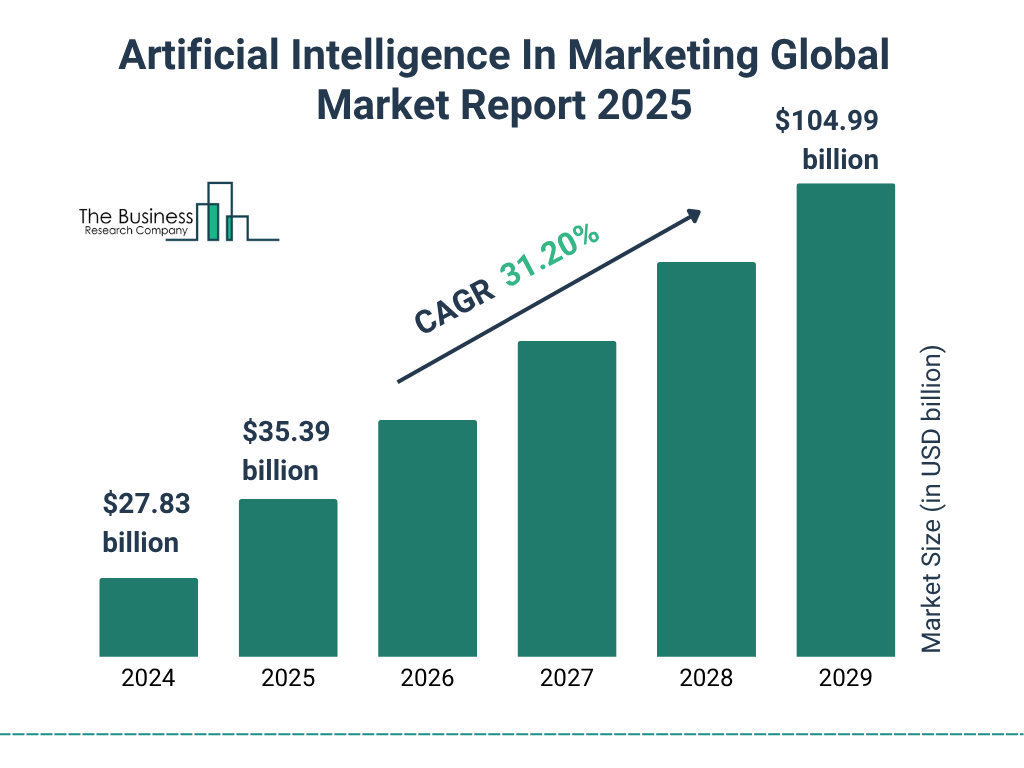
Source: The Business Research Company
That growth isn’t only the promise of a future. It’s the pressure for our present as well.
In this article, we’ll uncover the hidden risks of using AI in digital marketing. So we can discuss how to dodge them while marketing.
Top 15+ hidden risks of using AI in digital marketing
There could be numerous risks associated with your AI usage habits and dependency levels. However, according to a survey by Neil Patel, the following 7 risks are most commonly identified. I will discuss these first, and then continue with the ones that should also be discussed in the current scenario.
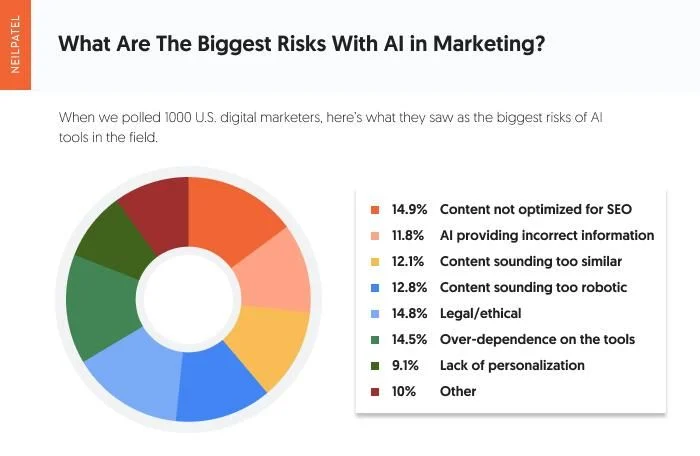
Source: NeilPatel
Content Not Optimized for SEO
AI tools can write fast, but not always smart. And that is required for SEO optimization. They often miss keyword placement, metadata, and search intent as they should. This leads to content that looks good but doesn’t rank.
To avoid that, always review AI-generated text for SEO fundamentals like headings, meta descriptions, and keyword balance. Use SEO tools such as SurferSEO or Clearscope to cross-check AI drafts before publishing.
One more thing, make it as simple as possible. So, people enjoy reading it. If you can’t do it yourself, ask an AI tool to help you, like the sentence rewriter, Jasper AI, Writesonic, and Quillbot. It has a simplifier tool especially for this task.
It just needs your sentences. Understands them and rewrites them in the simplest possible way.
Legal/Ethical Issues
AI tools often pull information from massive datasets without clarifying the source. This can accidentally include copyrighted or sensitive material. And create plagiarism risks or data privacy violations.
To avoid that, verify the originality of your AI-generated outputs. Use plagiarism checkers to avoid duplicate information and rewrite all the highlighted sentences with the help of AI rewriters. They will also change the tone and make it look like completely new content.
Over-Reliance on AI-Generated Content
Relying too much on AI is another major problem we face today. People are trying to use AI for almost everything. This is taking our human touch and creativity away from our work.
We need to use AI only for drafting or ideation, not for the final draft. Still, always edit the content to make sure it matches your brand’s unique voice and authenticity. This precaution will keep pace with AI and your creativity.
Content sounds too Robotic.
AI-generated text is usually grammatically perfect but emotionally flat. According to Bynder, 50% of readers can easily notice that it’s AI when something “feels” unusually bland and robotic.
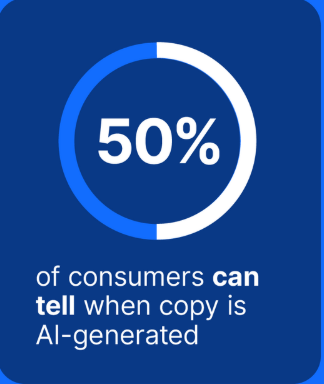
Source: Bynder
To make it more human, you need to add what humans have in their daily life conversations, like humor, empathy, descriptive grammar, and personal experiences.
For the descriptive grammar, you can rewrite your lines with an AI humanizer. I’ve found Detektify very accurate for this job. It is specially trained to do that. It reads your content to extract the context. Then rewrite it from scratch and make it look like a human wrote it in the first place.
The content sounds too similar.
Most AI tools are trained on the same public datasets. So it is not strange that their outputs resemble each other. That means someone else could end up publishing content that sounds just like yours.
That’s why it is important to add your own insights, examples, and tone to the AI text. So it has some human element. Use AI as a foundation, then rewrite it with your perspective to create a final output that is original and distinct.
AI is providing incorrect information.
AI tools don’t truly “know” facts. They observe your writing pattern and predict the next based on it. This can often lead to completely wrong statements. Especially with outdated or technical data.
Hence, you need to verify every AI-generated claim with credible sources. Use fact-checking tools and update statistics or references manually before publishing.
The easiest way is to ask the AI tool itself. Ask where it got the fact from. It will provide the source or accept that the fact or number is not real.
Lack of personalization
Users nowadays prefer everything that aligns with their likes and dislikes. 76% of consumers even get frustrated when the user experience is not personalized.
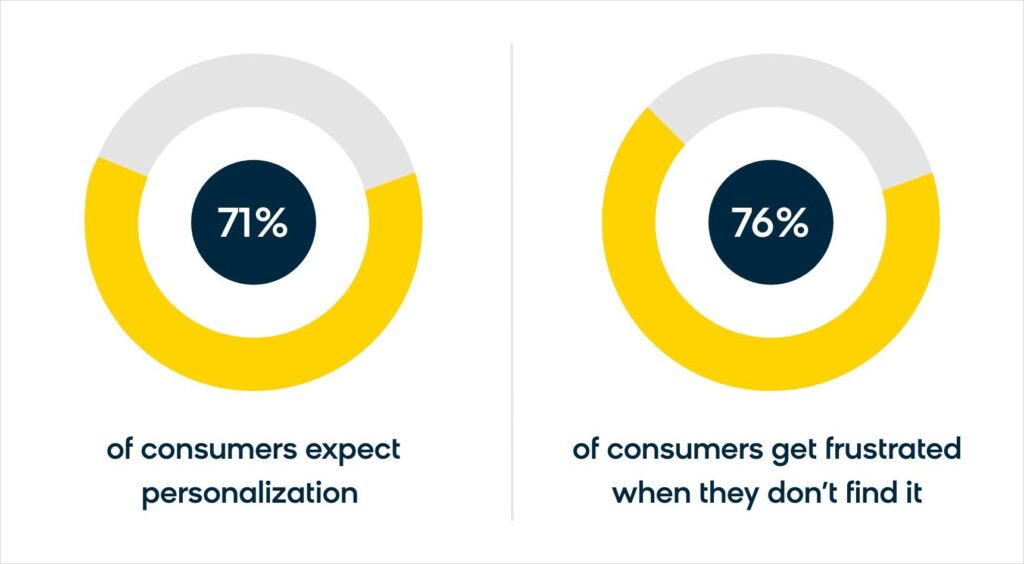
Source: Bloomreach
Hence, every message, every image, and even post timing must be predetermined by marketers in the modern digital space for better results. But AI tools do not realize that. Ask something ten times, and they will create similar content every time. Using that will ruin your campaigns.
So, you need to provide extra information regarding your target audience or your personalization plan. Then AI will be able to provide things differently.
Still, you have to change it further, because AI will not be enough.
Decline in brand authenticity and voice
When every piece of your content is AI-assisted, your own unique voice will slowly fade. With time, your brand might lose its voice and feel inconsistent across platforms.
That consistency is so important that experts even recommend that a single person write all your content across every platform. So the tone, message, and wording stay the same.
For that, you need to set clear brand guidelines for your messaging. Use AI to assist, but always give the final edit a human touch.
Biased ad targeting and exclusion
As we said before, AI models learn from existing data. And if that data is biased, your ad targeting will be too. Just like Deepseek AI says, Taiwan is not a country. That can lead to unintentional exclusion of certain demographics or unfair ad placements.
Regular audits are required to avoid that. Review your targeting parameters manually from time to time. Make sure you’ve diversity in your training data and customer personas.
Loss of human creativity in campaigns
New or aspiring marketers often find AI-generated ideas too good to be true and start relying on them. But over time, their campaigns become repetitive and uninspired because the spark of human imagination is missing.
See, AI is to be used only for research or brainstorming. Your human mind should be leading the creative direction. This combination of machine efficiency and human originality makes your campaigns stand out.
Data privacy and user consent risks
All the online tools collect and process massive amounts of customer data. Sometimes even without full transparency.
This can easily raise privacy concerns and violate data protection laws such as GDPR. 71% of users are already taking steps to improve their online privacy.
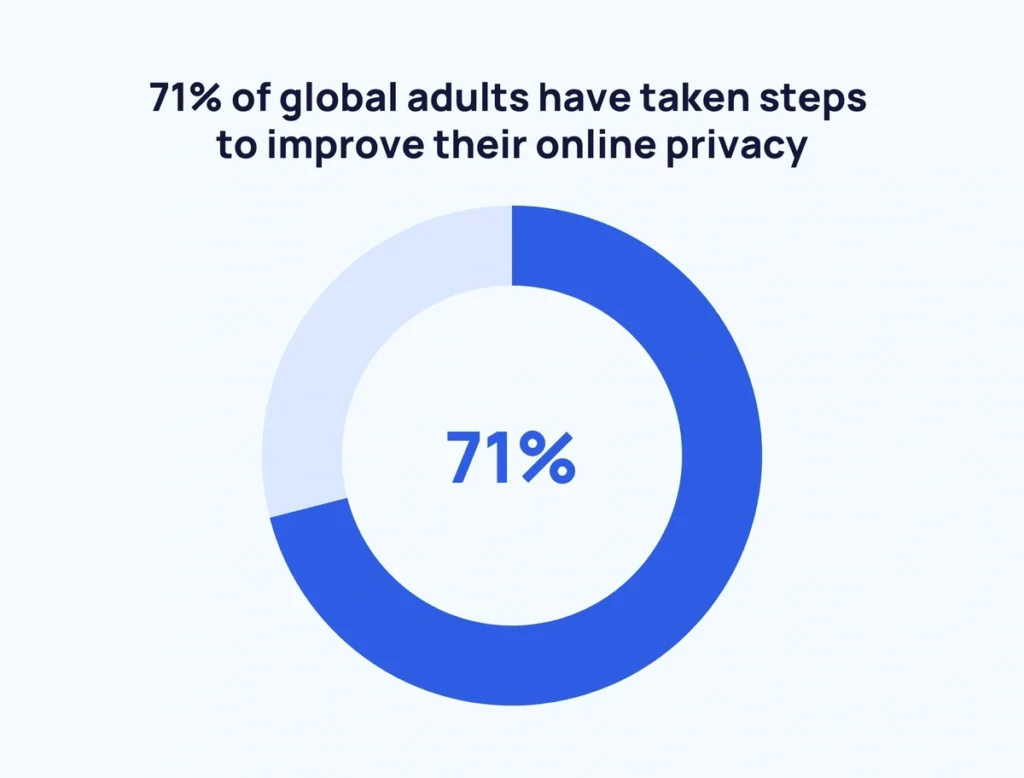
Source: Exploding topics
Therefore, always use AI platforms that comply with global data regulations. Also, disclose your AI to your users. Make privacy a feature of your marketing plan.
Security vulnerabilities in AI marketing tools
We often integrate AI marketing platforms with multiple systems, including CRMs, analytics, and ad networks. Our work becomes more convenient this way, but it is also an easier target for cyberattacks.
When 95% of American users are worried about data leaks, it can damage both reputation and customer trust.
If you want to avoid that, you need to choose AI platforms that offer strong encryption and transparent data-handling policies.
Still, you need to conduct regular security audits to ensure the workflow is up to date.
Regulatory non-compliance (GDPR, FTC, etc.)
AI tools often process user data without even telling them. They do it to train and improve their responses. It sounds good, but violates global privacy and advertising laws such as GDPR, CCPA, and FTC guidelines.
In fact, many marketers unknowingly risk heavy fines for using AI systems that mishandle personal data.
Hence, verify that your AI tools comply with international regulations before using them. Take user consent before collecting their data and tell people when your content is AI-generated. It will keep things fair.
Dependence on third-party AI platforms
Third-party vendors own most AI marketing tools. This means your campaigns and work depend on their pricing and data-handling policies.
If the service changes its terms or shuts down, your marketing operations could suffer instantly. So, do not put all your processes in one AI platform. Keep backups and maintain control of your marketing data.
Hidden costs and wasted ad budgets
AI tools often appear cost-effective at first. But you may also face a few hidden charges, such as API usage, premium models, or automation errors.
They can quietly use your ad budget. If your AI ad system is poorly tuned, it can even overspend or target the wrong audience.
Hence, you need strict budget control and continuous ad monitoring. Always test your campaigns before scaling them with automation.
Lack of transparency in AI decision-making
Most of us are not interested in finding out how AI tools work. We just want the output, not the process. This makes it difficult to understand why an ad was targeted a certain way or how a campaign decision was made. Such negligence leads to misjudgments.
Therefore, use only those AI tools that explain things and provide performance metrics. And do not rely on them completely; keep a human in the loop to review decisions.
Conclusion
Artificial intelligence is transforming digital marketing faster than anything. But speed without awareness is just a risk.
You need not avoid AI but use it responsibly. Know where it fits, where it fails, and where your judgment still matters most because the best marketers won’t be the ones using the most AI. They’ll be the ones who know how much is too much.
